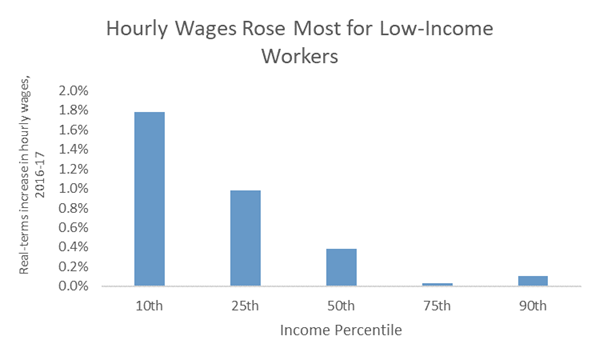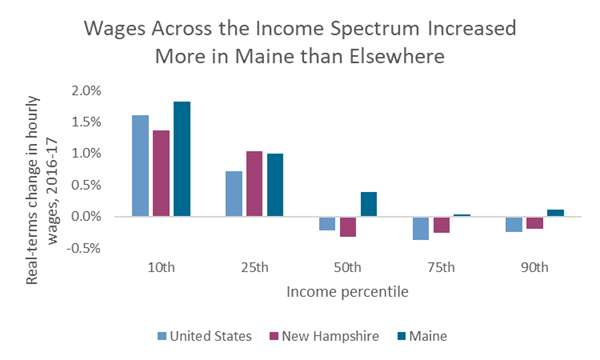New Occupational and Employment Statistics, or OES, data released Friday by the US Bureau of Labor Statistics continued to strengthen the case that Maine’s new voter-approved minimum wage law has successfully lifted Mainers’ wages without causing harm to Maine workers or Maine’s economy.
Conclusions drawn from this latest OES report data reinforce those MECEP found in a preliminary analysis in January, based on a the Quarterly Census of Employment and Wages, or QCEW, which reported aggregate wages paid statewide in the first half of 2017, along with average weekly earnings.
The QCEW data showed that the minimum wage law coincided with the largest annual wage gain in a decade and did not cause the job losses predicted by the minimum wage law’s opponents. Now, the OES data shows that the law also hasn’t spurred employers to cut their low-wage workers hours to “make up for” the increased wages.
Taken together, these data sets indicate the minimum wage law is working exactly as proponents had intended. Mainers are seeing more money in their paychecks, without the economy shedding jobs or employers cutting their employees’ hours.
Higher wages and more hours for low-income Mainers
The OES data reports hourly wages earned along the income spectrum, broken down by industry and geography. It shows that Maine’s low-income workers received their largest raise in more than 15 years, the entire period for which we have state-level data, after the implementation of the voter-approved law to increase the minimum wage. Real hourly wages increased faster than the cost of living across the income spectrum, but those in Maine’s lowest-paid occupations saw the biggest gains. Wage gains were felt across the state, and across occupation groups.
While the QCEW data I analyzed in January suggested that the minimum wage increase had caused overall earnings to climb in the lowest-wage industries, such as hospitality and retail, but the picture was incomplete. It was possible that raises earned by those at the very top of the income distribution were skewing the data, papering over relatively small increases or even flat earnings for minimum wage earners. Opponents of the new minimum wage law had argued, for example, that many employers would cut workers hours as their wages increased, which would result in no overall increase to earnings for those workers.
That’s where the OES data, with its hourly wage figures, comes in. Total employment covered by the OES data rose very slightly from 596,000 to 599,000 between 2016 and 2017. Meanwhile, a comparison of the average (mean) weekly earnings in the QCEW and the mean hourly wage in the OES shows that, on average, Mainers expanded their schedules, from 36.9 hours/week in 2016 to 37.1 hours/week in 2017.
With both data sets in hand, we can surmise that not only did total payroll in Maine increase after new minimum wage law took effect, but that the aggregate increase translated to higher hourly wages without any reduction in hours worked.
Lowest-paid workers saw largest wage gain on record
The scale of the wage gains for Maine workers in 2017 was significant. Gains were largest for the lowest-paid workers, consistent with the impact of the minimum wage raising the salary floor. For workers in the bottom one-fourth of Maine’s income distribution, wages rose 3%, and for the lowest-paid tenth of workers, hourly wages rose 3.8% — the largest increase in hourly wages going back to 2001, when the BLS began compiling statewide median wage data.
Source: MECEP analysis of US Bureau of Labor Statistics, Occupational Employment Statistics, 2016-17. Inflation based on CPI-U, 2016-17.
Minimum wage law raises workers’ real earnings in face of increased cost of living
These gains hold up even after accounting for the effects of the rising cost of living, as measured by the Consumer Price Index. Importantly, the minimum wage increase helped bring wages back to pre-recession levels. The $9.62/hour wage for workers at the 10th percentile had the same spending power as wages for that group in 2010. For workers at the 25th percentile, the increase brought wages back in line with 2009 levels.
For several years following the Great Recession, and in the absence of any minimum wage increases at the state level, the real value of wages had been eroded by the increased cost of living. The 2016 vote to increase the minimum wage to $9 corrected for that slide.
Comparison with occupational wage data elsewhere show that the gains in Maine are attributable to the minimum wage increase, rather than other phenomena, such as a tightening labor market. Wages in Maine increased faster than nationally, and faster than wages in New Hampshire, the only New England state without a minimum wage increase in 2017.
Source: MECEP analysis of US Bureau of Labor Statistics, Occupational Employment Statistics, 2016-17. Inflation based on CPI-U, 2016-17.
Benefit of higher wages shared across the state
Wages increased throughout the state. The BLS measures wages in Maine’s three metropolitan statistical areas (Bangor, Lewiston-Auburn and Portland-South Portland), and two non-metropolitan areas. Hourly wages increased significantly in all five regions. The gains were largest in the Bangor metropolitan area, and significant for low-wage workers in Maine’s rural areas.
| 10th Percentile | 25th Percentile | 50th Percentile | 75th Percentile | 90th Percentile | |
|---|---|---|---|---|---|
| Bangor | 3.9% | 2.0% | 2.2% | 0.2% | 2.3% |
| Lewiston-Auburn | 0.5% | -0.4% | 1.6% | 0.2% | 0.2% |
| Portland-South Portland | 2.2% | 1.9% | 0.1% | -0.2% | 1.1% |
| Northeastern Nonmetro | 2.4% | 0.3% | 0.7% | -0.6% | -0.9% |
| Southwest Nonmetro | 2.3% | 0.2% | 0.0% | -0.5% | -1.0% |
Above: Real-terms wage increases in Maine’s metro and non-metropolitan regions. Source: MECEP analysis of US Bureau of Labor Statistics, Occupational Employment Statistics, 2016-17. Inflation based on CPI-U, 2016-17.
Conclusion
The data continue to show that Maine’s 2017 minimum wage increase was a success, and that critic’s fears were unfounded. Wages for low wage workers received their biggest boost in more than fifteen years, and other workers continued to see real-terms increases. Wage gains were felt across an array of occupations, and in every part of the state. These findings confirm MECEP’s research prior to the wage increase and should create caution against efforts to tamper with the minimum wage law.





